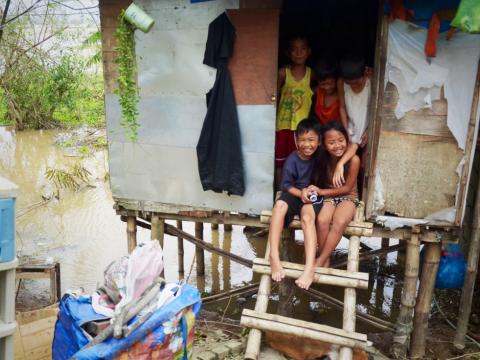Little children recount how they survived Typhoon Koppu

By Lanelyn Carillo, Field and Emergency Communication Specialist
Tucked in a corner of a long narrow village road is a house on stilts, standing strong against the brownish floodwater with floating water lilies. The floodwaters were triggered by Typhoon Koppu (Lando), which brought heavy winds and strong rain across Northern Luzon.
An open cabinet, muddied clothes, damaged electric fans, wet toys and shoes were piled up in disarray in the front yard. In the corner, a noddle soup is brewing in a pot.
"Xanniyah, could you help me with this?" Carol, 30, calls out. A little girl walked down the bamboo stairs slowly.
Carol continues, "Kindly bring the dust pan too." The little girl obliged and went back inside the house.
"The wind kept flapping the tarpaulin covering our windows. It was so noisy. I wanted it to stop. I also thought our roof will be blown away."
Inside the house, four young boys were playing and giggling. The little girl joined the game again.
"After the typhoon, they’re still not in school so they have plenty of time to play," says Carol, Xanniyah's aunt, checking what the children are doing.
Typhoon Koppu (local name Lando) brought heavy rains and flooding in Pangasinan province. Strong winds toppled most trees and electric posts, and destroyed many houses. For three days, most villages in the province have had no electricity. School has been suspended for nearly a week now.
After playing, the little boys began talking about a small Super Mario look-a-like toy figure. Xanniyah is uninterested. She sits on the stairs and stares blankly to anyone passing by their house.
"I love both going to school and playing," she says. Xanniyah has been a good student, earning awards and medals for performing well in school. "Last year, I was the first honour. But I couldn't show you my medal yet because, I think, the flood took them away. I couldn't find them now. Or maybe they are somewhere around here."
Xanniyah recalls the day Typhoon Koppu's strong winds and rains swept most houses in the neighbourhood, including the house of her aunt. "We all stayed in this house--me, my brother Carlo, Uncle and Aunt Carol. The wind kept flapping the tarpaulin covering our windows. It was so noisy. I wanted it to stop. I also thought our roof will be blown away," she says.
"Now, I don't have papers to use for school. The floodwater swept it away. I still have my bags, shoes and uniforms but they are filled with mud."
Xanniyah and Carlo's father left them with their mom when they were still young. Their mother was forced to work away as a house helper to provide for the needs of the children. The children live with their aunt and uncle.
As they hear the story of Xanniyah, the other children became followed. "We stayed inside our room while the typhoon was hammering our house," Daniel, 9, says. "It was scary. I heard faint cries of babies. They got scared, too."
Carlo continues Xanniyah's story. "We were staying in our aunt's house down there," Carlo says, pointing to his aunt's house. "Then the flood was rising fast but we quickly evacuated. We stayed here for several hours, waiting for the typhoon to subside until I fell off to sleep." The children laughed as Carlo demonstrates how he slept in a corner.
Another child, John, 8, adds, "A portion of house was blown away along with some of our things. Now, I don't have papers to use for school. The floodwater swept it away. I still have my bags, shoes and uniforms but they are filled with mud. My mother is cleaning them."
"You should help your mother," Xanniyah teases John. Xanniyah continues, "I hope there will be no more typhoon like that. Look at what it has done to our village. It looks like a river now. We can’t play outside.”
The National Disaster Risk Reduction and Management Council reports that at least 295,835 families or 1.4 million people are affected across six regions in Luzon.
Typhoon Koppu brought torrential rains that turned the farmlands in Pangasinan into a river. People now use boats on the same road that they used to walk on.
As of Oct 23, the National Disaster Risk Reduction and Management Council (NDRRMC) reports that at least 295,835 families or 1.4 million people are affected across six regions in Luzon. The death toll rose to 46 and there were 82 injured. The fierce storm had been lingering around the region at slow pace, setting off floods and landslides across many villages.
Initially, World Vision will dispatch prepositioned relief items such as blankets, mosquito nets, sleeping mats, soaps, and toothpastes to 2000 affected families in the worst affected villages in Pangasinan. World Vision field staff also coordinates with the local social welfare to ensure that children are safe and protected.
World Vision has been assisting more than 1,473 families in Pangasinan through educational assistance, livelihood program, and other community development projects.